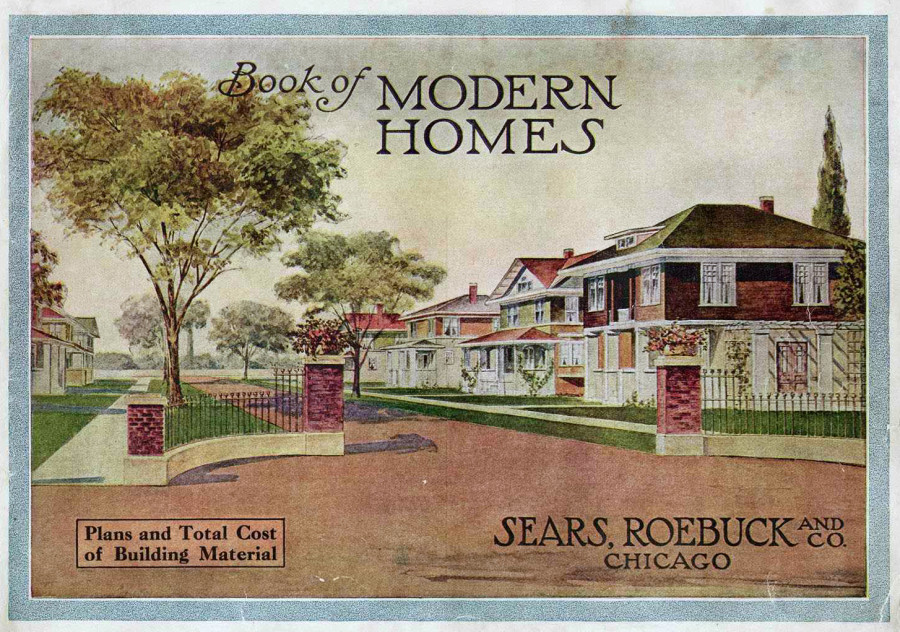Sears Flatpack Homes: Revolutionising the American Dream in the 1920’s

Image source here.
In the roaring 1920’s, the American Dream took on a new form – the Sears flatpack home. As the nation embraced a period of economic prosperity and suburban expansion, Sears, Roebuck and Co., the iconic retailer, stepped into the housing market, offering affordable, ready-to-assemble homes through its catalogue. This article delves into the fascinating world of Sears flatpack homes, exploring their origins, their unique allure for American families, and their lasting impact on the architectural landscape.
Origins of Sears Flatpack Homes: An Unlikely Retailer in the Housing Market
Sears was initially a mail-order company before entering the housing market in 1908 with the introduction of ready-cut homes. However, it was in the 1920’s that the concept gained momentum. Leveraging its extensive catalogue distribution, Sears offered a diverse range of home designs, providing blueprints and all necessary materials, from lumber to nails, in a single package. This innovative approach made homeownership accessible to a broader demographic, including the burgeoning middle class.
Variety in Design: From Bungalows to Colonial Revivals
Sears flatpack homes were not one-size-fits-all. The catalogue boasted a diverse selection of architectural styles to suit various tastes. The options were vast, from charming bungalows and cosy cottages to stately Colonial Revivals. Each design came with detailed floor plans and construction guides, allowing prospective homeowners to choose a residence that mirrored their aspirations.
Affordability and Accessibility: Fulfilling the American Dream
At the heart of the Sears flatpack home phenomenon was affordability. The kits were priced competitively, making homeownership an achievable goal for many Americans. The easy accessibility through the mail-order catalogue streamlined the process, eliminating the need for an architect. Families could now bypass the traditional complexities of homebuilding, realising their American Dream with a simple order.
DIY Construction: The Challenge of Building Your Dream
Constructing a Sears flatpack home was a family affair. While the kits included all the necessary materials, the construction process required significant time and effort. Families had to transform into amateur carpenters, working together to raise the walls and lay the foundation of their dream home. This hands-on approach contributed to cost savings and fostered a sense of pride and accomplishment among homeowners.
Quality and Craftsmanship: The Sears Seal of Approval
Despite being DIY projects, Sears flatpack homes were synonymous with quality. The materials provided were carefully selected, and each kit underwent rigorous quality control. Sears guaranteed satisfaction, and the company's reputation for reliability extended to its housing. The iconic Sears logo on the materials was a seal of approval, ensuring homeowners that their investment was in good hands.
The Cultural Impact: Beyond Brick and Mortar
Sears flatpack homes left an indelible mark on American culture. As suburbs burgeoned, these homes became symbols of upward mobility and the pursuit of a better life. Communities of Sears homeowners formed, creating a unique camaraderie among families who had shared the experience of constructing their residences. The homes themselves became testaments to the spirit of innovation and self-sufficiency that defined the era.
Legacy and Recognition: Unveiling the Sears Home Today
While the production of Sears flatpack homes ceased in the 1940s, many still stand today. Recognising the historical significance, preservationists and enthusiasts have embarked on initiatives to identify and catalogue Sears homes across the country. Online databases and local historical societies collaborate to trace these architectural relics, preserving an essential chapter in American housing history. Between 1908 and 1940, over 70,000 Sears catalogue homes were sold, and approximately 50,000 still stand today.
Conclusion: The Enduring Legacy of Sears Flatpack Homes
The Sears flatpack homes of the 1920’s were more than just houses; they were a testament to an era of change and innovation. Through affordability, accessibility, and a touch of DIY spirit, Sears allowed countless families to realise their dreams of homeownership. Today, these homes stand as silent witnesses to a transformative period in American history.